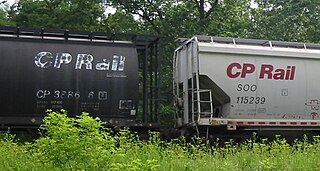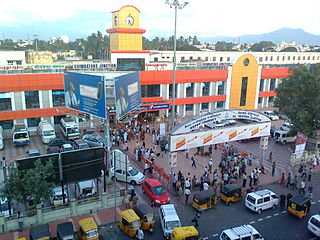
Commuter rail, or suburban rail, is a passenger rail transport service that primarily operates within a metropolitan area, connecting commuters to a central city from adjacent suburbs or commuter towns. Commuter rail systems are considered heavy rail, using electric or diesel trains. Distance charges or zone pricing may be used.

An IATA airport code, also known as an IATA location identifier, IATA station code, or simply a location identifier, is a three-letter geocode designating many airports and metropolitan areas around the world, defined by the International Air Transport Association (IATA). The characters prominently displayed on baggage tags attached at airport check-in desks are an example of a way these codes are used.

The Kwun Tong line is a rapid transit line of the MTR network in Hong Kong, coloured green on the MTR map. Starting at Whampoa in Hung Hom and ending at Tiu Keng Leng in Tseung Kwan O, Sai Kung, the route has 17 stations and takes 35 minutes to complete. The Kwun Tong line is one of the busiest railway lines on the network connecting the central and the eastern portions of Kowloon via Wong Tai Sin. The line is mostly underground, but includes a lengthy elevated section, and runs generally in an east-west direction. During the morning rush hour, the Kwun Tong line utilises 33 trains running at 29tph to achieve a route capacity of 85,000 pphpd.

A reporting mark is a code used to identify owners or lessees of rolling stock and other equipment used on certain rail transport networks. The code typically reflects the name or identifying number of the owner, lessee, or operator of the equipment.
In a writing system, a letter is a grapheme that generally corresponds to a phoneme—the smallest functional unit of speech—though there is rarely total one-to-one correspondence between the two. An alphabet is a writing system that uses letters.
A location identifier is a symbolic representation for the name and the location of an airport, navigation aid, or weather station, and is used for staffed air traffic control facilities in air traffic control, telecommunications, computer programming, weather reports, and related services.
In Unicode, a script is a collection of letters and other written signs used to represent textual information in one or more writing systems. Some scripts support one and only one writing system and language, for example, Armenian. Other scripts support many different writing systems; for example, the Latin script supports English, French, German, Italian, Vietnamese, Latin itself, and several other languages. Some languages make use of multiple alternate writing systems and thus also use several scripts; for example, in Turkish, the Arabic script was used before the 20th century but transitioned to Latin in the early part of the 20th century. More or less complementary to scripts are symbols and Unicode control characters.

Rapid transit or mass rapid transit (MRT), also known as heavy rail or metro, is a type of high-capacity public transport that is generally built in urban areas. A rapid transit system that primarily or traditionally runs below the surface may be called a subway, tube, or underground. Unlike buses or trams, rapid transit systems are railways, usually electric, that operate on an exclusive right-of-way, which cannot be accessed by pedestrians or other vehicles. They are often grade-separated in tunnels or on elevated railways.

Coimbatore Junction Railway Station, also known as Kovai Junction Railway Station, is a major railway station located in the city of Coimbatore in the state of Tamil Nadu, India. It is one of the busiest railway stations in South India and serves as a gateway to the Nilgiri hills, a popular tourist destination. The station is operated by the Southern Railway zone of Indian Railways and has six platforms. Coimbatore is the third highest revenue generating station in the Southern Railway after Chennai Central and Egmore railway stations and is the station that generates about 45 percent of the revenue of the Salem Railway division. Coimbatore Junction is an important junction connecting major cities such as Chennai, Bangalore, Mumbai, Delhi, and Kolkata. It also serves as a gateway to several popular tourist destinations such as Ooty and Kodaikanal. Although Coimbatore railway station has the suffix Junction in its name, it's not a true junction. No new line starts from or ends at Coimbatore. It's just a passing railway station lies between Podanur Junction and Coimbatore North Junction.

Koderma Junction railway station, station code KQR, is railway station of the Indian railway under Dhanbad railway division of East Central Railway zone serving the city of Jhumri Telaiya, Koderma, the headquarters of Koderma district in the Indian state of Jharkhand.

Manmad Junction Railway Station is a Central Railway junction in India, serving the town of Manmad in the Nashik district of Maharashtra. It is one of the Central Railways' major stations, connecting Manmad with many major cities in the region, including Mumbai and Pune. Around 51 trains travel between Mumbai and Manmad railway stations every week.

Kalaburagi Junction railway station, formerly Gulbarga Junction railway station is located in Kalaburagi district in the Indian state of Karnataka and serves Kalaburagi. It is identified as one of the A1 category Station in 2016.

Ludhiana Junction railway station is a railway station located in Ludhiana district in the Indian state of Punjab and serves Ludhiana. It is located in about the centre of the city and is among the busiest railway stations of Punjab. It is also among the cleanest of railway stations of India.
Jalandhar City Junction is a railway station located in Jalandhar district in the Indian state of Punjab and serves Jalandhar.

Chandigarh Junction railway station, serves the union territory city of Chandigarh. The station is at an elevation of 330.77 metres (1,085.2 ft) and was assigned the code – CDG. Chandigarh is amongst the top hundred booking stations of the Indian Railway.
Patiala railway station is a railway station serving Patiala city of Punjab in India. It is under Ambala railway division of Northern Railway zone of Indian Railways. It is located at 256 m (840 ft) above sea level and has four platforms. 24 trains stops, one train originates and one train terminates here.
Chandrapur railway station is a railway station serving Chandrapur city in Chandrapur district of Maharashtra state of India. It is under the Nagpur CR railway division of Central Railway zone of Indian Railways. It is located on the New Delhi–Chennai main line of Indian Railways.
The Delhi–Mumbai line is a major railway line in India. Linking the national capital of New Delhi with financial capital Mumbai, this railway line covers a distance of 1,386 kilometres (861 mi) across the Indian states of Delhi, Haryana, Uttar Pradesh, Madhya Pradesh, Rajasthan, Gujarat and Maharashtra. Mumbai Tejas-Rajdhani Express which is the fastest Tejas-Rajdhani Express travels on this line and covers the distance between Delhi and Mumbai in 15 hours and 40 minutes at a top speed of 130km/h and an average speed of 91 km/h.

Station numbering is a sign system which assigns station codes consisting of a few letters and numbers to train stations. It aims to facilitate navigation for foreign travelers not familiar with the local language by using globally understood characters. The system is now in use by various railway companies around the world such as in Mainland China, Indonesia, Japan, South Korea, Singapore, Taiwan, Thailand, and the United States.












